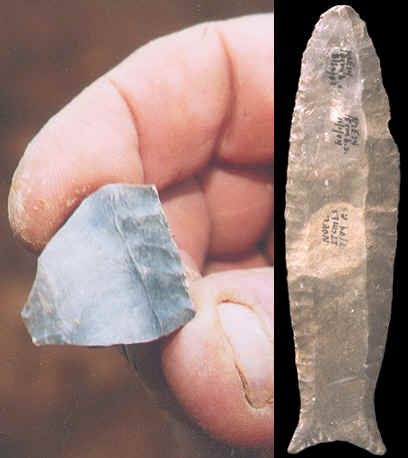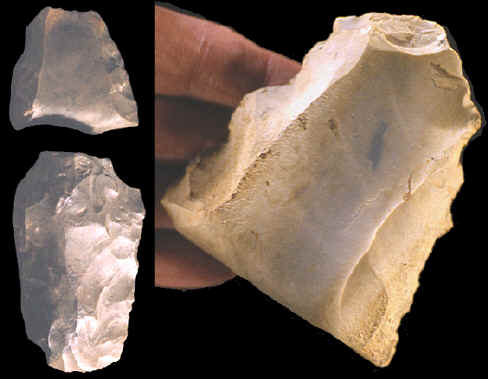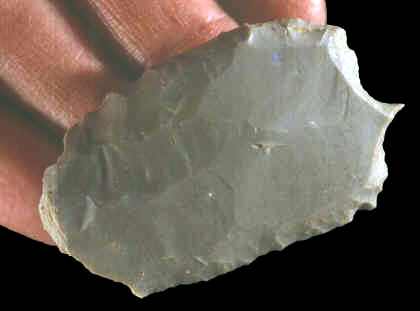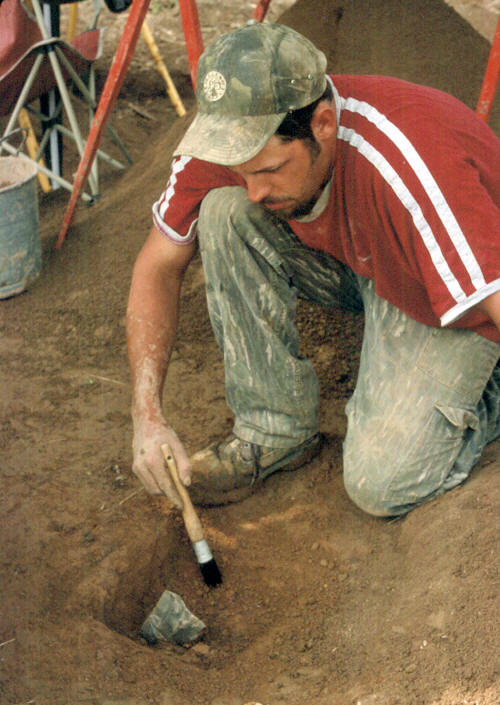|
The Phil Stratton site has produced thousands of
manufacturing debris flakes. The site is located within an area rich in
good quality raw material. The gravels of the Red River supplied the
Cumberland people with all the stone tool making materials they needed.
|
|

PHOTO
CREDIT RICHARD M. GRAMLY
CLICK ON
PICTURE FOR LARGER IMAGE OF POINT
CUMBERLAND POINT
PHIL STRATTON CUMBERLAND
SITE
LOGAN COUNTY, KENTUCKY
To date, this is the only complete Cumberland point found on the
Phil Stratton site. It was reassembled from four fragments that
were unearthed separately since 1999. This point is made of St.
Genevieve chert and probably measured about 4 inches (10 cm) long
when it was new. |
|
|
Since 1999 the Phil Stratton site has produced 200
various types of utilized stone tools. These include various types of
scrapers, gravers, a drill, denticulates and projectile points.
|
|

PHOTO
CREDIT (left picture) RICHARD M. GRAMLY
CLICK ON
PICTURE FOR TRIPLE IMAGE OF PREFORM AT RIGHT
CUMBERLAND PREFORM
MANUFACTURING BREAKS
PHIL STRATTON SITE (left)
& NEARBY PHIL STRATTON SITE (right)
LOGAN COUNTY, KENTUCKY
These three artifacts are proof that the Phil Stratton site was a
stone tool manufacturing site. Both of these early stage Cumberland
preforms were broken during fluting when the channel flakes dove
inward. The example on the left was found in the 2004 excavation in
units S5E14 and N2E12 on the Phil Stratton site. The lower end
fragment (distal) was retouched by pressure flaking and used as a
scraper. This preform is made of St. Genevieve chert and measures 2
15/16 inches (7.5 cm) long.
The broken preform base on the right was found by
Ms. Madison Stratton on the opposite side of the ravine from the
main locus of the Phil Stratton site at the end of May, 2005. It is
made of St. Genevieve chert. |
|
|
Of particular interest is the lack of end-scrapers on
the Phil Stratton site. The most common tool form on other early
Paleo-Indian sites, except for utilized flakes, are end-scrapers. Clovis
sites are known for producing large numbers of end-scrapers. Other
sites, such as Goshen and Folsom, also produce fair numbers of
end-scrapers. So far, the Phil Stratton site has produced only one
"normal" end-scraper and one "odd" example that has
a denticulated edge. The most common tool type so far discovered on the
Phil Stratton site, except for utilized flakes, are side-scrapers. They
were made from blades struck from prepared cores.
|
|

CLICK ON
PICTURE FOR LARGE TRIPLE IMAGE
GRAVER /
SIDE-SCRAPER
PHIL STRATTON CUMBERLAND
SITE
LOGAN COUNTY, KENTUCKY
A
CAST OF THIS GRAVER IS AVAILABLE FOR SALE
This combination graver and side-scraper was found during excavation
on the Phil Stratton site in 2005. The bulb of percussion, where the
blade was struck from the core, is still evident on the end even though
it has been partially trimmed away by pressure flaking. This graver
/ side-scraper is made of St. Genevieve chert and it measures 2 1/4
inches (5.7 cm) long. |
|
|
The most diagnostic tool form found on the Phil
Stratton site are four Cumberland points. They give the site a reference
point for comparison to other fluted point sites. Without them, the site
could still be identified as a Paleo-Indian site but it would be
difficult to identify it as a Cumberland site. Cumberland points were
named by Thomas M.N. Lewis after the Cumberland River Valley in
Tennessee, where several examples have been found (Perino, Greg 1985).
|
|

PHOTO
CREDIT RICHARD M. GRAMLY
EXCAVATING A
PRISMATIC BLADE CORE
PHIL STRATTON CUMBERLAND
SITE
LOGAN COUNTY, KENTUCKY
Jason Neralich is shown excavating a prismatic blade core on the
Phil Stratton site on May 11, 2004. This core is made of St.
Genevieve Formation chert. It was evidently abandoned anciently due
to an internal flaw. This core was discovered 19 3/4 inches (50 cm)
below the surface. |
|
|
The excavation of the Phil Stratton site will
undoubtedly produce important new information to add to the
archaeological record. It will be interesting to see if the ratio of
end-scrapers compared to side- scrapers with remain low. But whatever
the ultimate data will show for the Phil Stratton site, it wouldn't be
possible without the people who volunteer their time to painstakingly
gather clues from the past---bravo to them.
|
|
"REFERENCES"
1985,
Gregory Perino, "Selected Preforms, Points and Knives of the North
American Indians, Vol. 1," p. 94.
2005,
Richard Michael Gramly, "Archaeological Investigations of the Phil
Stratton site, 1999-2004: A component of the Cumberland / Barnes
tradition," The Amateur Archaeologist, pp. 39-60.
Personal communications with Mike Gramly.
|
|
RECENT
LISTINGS HOME
ORDERING |




